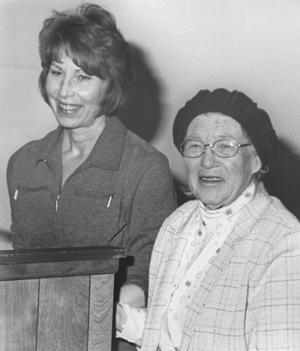Cuny Table is unique in several ways

A Chadron State College English professor with a passion for history has joined Hot Springs resident Virginia Kain Lautenschlager in telling the unique story of the hardy families that settled on Cuny Table in the western portion of the Pine Ridge Reservation.
With Virginia nearby listening to every word, Dr. Kathy Bahr summarized the history of Cuny Table during last week’s Phi Alpha Theta History Fraternity program at CSC.
Four years ago, Bahr worked with students in her Composition II course in interviewing and writing stories about more than 30 World War II veterans and other members of “the Greatest Generation.” The exhibit that was developed is now a part of the Library of Congress’ Veterans History Project.
Bahr is now seeking help in publishing the Cuny Table history after she edited the vast amount of information that Lautenschlager collected.
Bahr said Cuny Table is unique for both its geological formation and its culture. The table is about 15 miles long and three to four miles wide, rising about 300 feet from the floor of the South Dakota badlands. It once provided an excellent lookout for Indians. The culture is interesting because several men of European descent took Indian maidens as their wives while settling there. Over the years, the offspring from these couples often married neighbors until many of the Cuny Table families are intertwined. Bahr said it is now almost impossible to determine the percentage of European/Native American blood flowing in the veins of the present inhabitants.
Names prominent on the table besides Cuny include Pourier, Twiss, Swallow and Speck.
The table was named after Charles Cuny Sr., who moved to the area with his mother Josephine and his seven younger brothers and sisters in 1880 after the husband and father, Adolph Cuny, was shot during a stage coach robbery near Fort Laramie, Wyo., where the family had a ranch and trading post.
Children of Charles and Louise Cuny married into each of the families previously mentioned. Charles and Louise’s grandson, David Cuny, is among those who ranch on the table.
Virginia Lautenschlager’s parents, Ruben and Anna Marie Kain, purchased a quarter section on Cuny Table in 1926. Virginia recalls that survival was challenging in the ensuing years. She said that shortly after the stock market crash in 1929, her father shipped a carload of cattle to Omaha and cleared just $30.
Now 80, Virginia became a nurse during World War II. In 1948, she and her husband moved to Hot Springs, where she worked at the Lutheran hospital for 34 years. After retiring, she started gathering information about Cuny Table and wrote a 70-page booklet in 1984. All 250 copies quickly sold.
Since then, Virginia has collected more information and made some corrections suggested by readers of the first volume. Bahr and Virginia became acquainted a few years ago while Virginia and her husband were having an automobile repaired at the business owned by Bahr’s husband.
After learning of Virginia’s work, Bahr’s passion for history led her to volunteer to edit the material. Now they are searching for assistance in publishing the revised story.
There’s another sidelight to the history of Cuny Table. In 1942, the military bought out a number of the original families on Cuny Table to establish a bombing range. While the bombing range line was only 100 yards from their home, the Cunys did not have to leave, but the Kains were among those affected. A bull’s-eye was laid out in their pasture.
The Air Force used the range until 1958 and the National Guard used it for maneuvers until 1974. The land was eventually returned to the Oglala Sioux Tribe. However, much of it was contaminated by spent metal and other materials. Bahr said the cleanup is continuing.
Category: Campus News, Social Sciences
